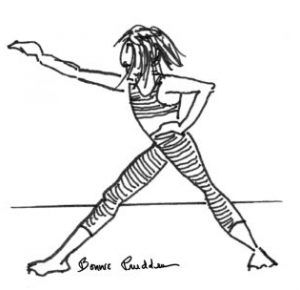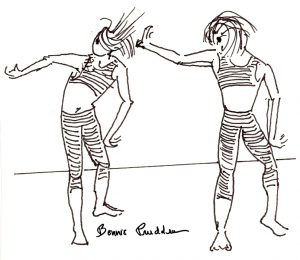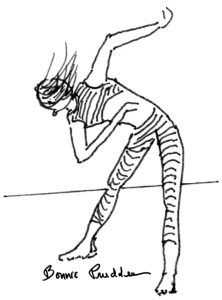WHY
- Proper and consistent stretching equal more flexible muscles.
- Strength plus flexibility in the proper timing and intensity yield coordination.
- Flexible muscles perform better since they are able to give up their tension. No matter how strong you are, you are missing one half your potential if you are inflexible.
- Flexible muscles have less chance of being injured since flexible muscles give rather than tear. Even if there is an injury is it usually less severe.
- Flexible muscles mean happier joints.
- Flexible muscles ensure you will be less tired. Endurance depends to a great extent on the ability of muscles to give up contraction and go to full stretch. When one set of muscles is constantly fighting another set that cannot relax, you get tired. Working against tight, uncooperative muscles is exhausting. This is especially true where the athlete is concerned. The Importance of Flexible Muscles – Bonnie Prudden Myotherapy
WHEN
Stretch exercise should be performed when the body is properly warmed up.
THE WARM-UP
“All physical activity should be preceded with warm-up exercise. People have begun to hear about warm-ups, but most confuse it with stretch because they don’t know what warm-ups are for or what they do.”
THE PURPOSE OF WARM-UP
“The purpose of a warm-up is to ready the muscles for action.”
“They protect against injury, since warm muscles are twenty percent more efficient than cold muscles, the warm-up determines your performance.”
“Warm-up exercises are designed to get the heart beating faster so that larger amounts of warm, oxygenated blood flows faster to the extremities you expect to use in the activity.”
“The system by which these qualities are obtained involves the body’s pump, the heart. The heart needs to be primed a little and the motor brought to a higher level of function before exercising. This is accomplished via exercises that increase heartbeat but neither stretch nor strain cold muscles.”
 WHAT IS A WARM-UP?
WHAT IS A WARM-UP?
“Warm-up exercises are done from a standing, spread-leg position, and involve arm swings, waist twists, hip and shoulder rotations, half and full knee-bends, toe rises, ceiling reaches, overhead lateral reaches, crawl strokes, back-strokes, breast strokes – anything that will not strain muscles but will get the heart beating and raise a sweat.”
“A good warm-up is rhythmic, swinging exercise done to music and with feet flat on the floor. Such exercise is usually done for anywhere from 3 to 10 minutes. When you can feel your heart beating a tattoo and there is a film of sweat on your upper lip, you know that your extremities are getting the warming blood they need for whatever you are going to do next.” Always Warm-Up First! – Bonnie Prudden Myotherapy
Daily Dozen Part I: Teaching Version
Daily Dozen Part II: Follow Along
HOW
How to stretch, like many things, lends itself to controversy and many opinions. As a young person I was introduced to ballistic stretch during my years of ballet classes. They were always done at the very end of the class and I remember them well. When I checked out what is purported to be ballistic stretch on You Tube it is not what I experienced in my dance classes, not even close. When performed correctly the gentle, rhythmic pulsing of ballistic stretch encourages the muscles to “let go.”
 The first time I became aware of static stretch was when I was teaching at the University of New Hampshire in 1970. A professor in the men’s physical education department was very excited about the book he had received to review and he loaned me his copy. Since I respected him I read the book and tried out the stretches. After trying them and giving them some time to work my conclusion was that they were restrictive and not comfortable for my body. It felt as if my muscles were fighting themselves and didn’t feel right for my body.
The first time I became aware of static stretch was when I was teaching at the University of New Hampshire in 1970. A professor in the men’s physical education department was very excited about the book he had received to review and he loaned me his copy. Since I respected him I read the book and tried out the stretches. After trying them and giving them some time to work my conclusion was that they were restrictive and not comfortable for my body. It felt as if my muscles were fighting themselves and didn’t feel right for my body.
Ballistic stretch which has been used by dancers for thousands of years seems to have received a bad name because more recently the stretches were not performed correctly. Rather than a gentle pulsing after thoroughly warming the muscles, they were done with more of a jerky, bang, and wham and often without warm-up. Done correctly ballistic stretch does NOT involve quick and sudden movements and should NOT be used as a warm-up.
I repeat: When performed correctly
the gentle, rhythmic pulsing of ballistic stretch
encourages the muscles to “let go.”
 NO MATTER WHAT STRETCH YOU ULTIMATELY DECIDE TO USE, IT IS BETTER PERFORMED IF:
NO MATTER WHAT STRETCH YOU ULTIMATELY DECIDE TO USE, IT IS BETTER PERFORMED IF:
- YOU TAKE THE TRIGGER POINTS OUT FIRST WHICH WILL ALLOW THE MUSCLE TO RELAX. If you have a rope with knots in it, pulling on the ends is not going to untie the knots. Untie your muscle knots with Bonnie Prudden Myotherapy and the muscles will relax and perform better.
- IF YOU ARE THOROUGHLY WARMED UP. A WARM MUSCLE IS 20% SAFER AND MORE EFFICIENT THAN A COLD MUSCLE.
My friend Ron Jones, MS, Historical Kinesiologist, and Physical and Health Educator says this about ballistic stretch:
“The ballistic stretching with bounces was indeed vilified by flawed science that defied history and common sense. When done properly, such as demonstrated for decades by people like Bonnie Prudden, the ballistic stretching is FAR more efficient and beneficial. The whole stretching fiasco is just another example of what happens when people don’t understand history and put too much faith into the “latest scientific studies” that often times completely ignore the fundamentals.
I put a lot of faith into my own observations. I can clearly see Bonnie moving well over age 50 in her videos and TV shows. She knew how to move well and keep moving that way. She had such aesthetic quality to her movements too which is a joy to observe. I used to teach seniors at the community college. I had them static stretching for a couple of years with no improvements. As soon as I went controlled bouncing ballistics — they immediately got better even if over age 80. I know what I see and feel in my own body.”
Have You Been Hamstrung By Your Hamstrings? – Bonnie Prudden Myotherapy
The Importance of Flexible Muscles – Bonnie Prudden Myotherapy
——————————————————–
If you have questions or need help, email me at enid@bonnieprudden.com.
For more information about Bonnie Prudden®, Bonnie Prudden Myotherapy®, workshops, books, self-help tools, DVDs, educational videos, and blogs, visit www.bonnieprudden.com. Or call 520-299-8064 if you have questions or need help. Enid Whittaker, Managing Director, Bonnie Prudden Myotherapy®